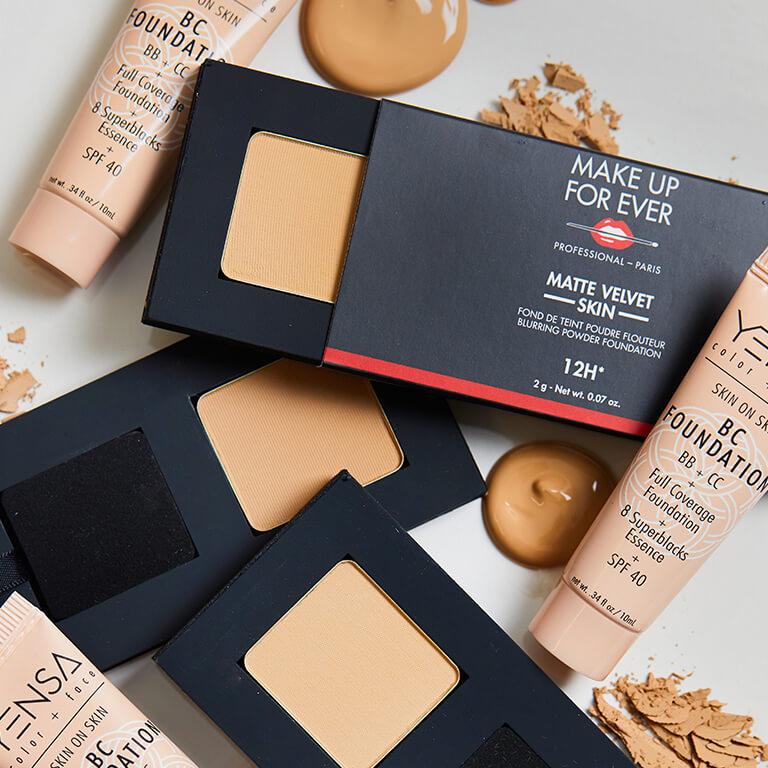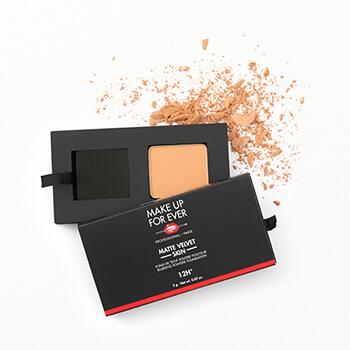7 Types of Foundation: Which One's For You?



Pia Bhattacharya


As you know, a good foundation makes everything stronger and last longer—and that includes your makeup. That’s why foundation is the first and arguably most important step in your makeup routine. Not only does it create a barrier between your makeup and skin’s oils (that can make your makeup splotchy), foundation creates an even canvas for color, and gives it all something to grip on to.
But if you’ve ever spent more than one minute in a makeup aisle, you know there are so many types of foundation to choose from. Liquid, BB, CC (have you pulled out your dictionary yet?), whipped, stick—and they each vary in texture, ingredients, and application techniques. Before you give up and ::gasp:: skip your foundation altogether—we’ve broken down the 7 types of foundation and what they do with a little help from New York City-based Makeup Artist, Kale Teter. Read on to find the right formula for you, and kiss your foundation fears goodbye.


It's about glam time you treated yourself.
But First, Prep Your Skin
No matter what type of foundation you’re using, you want to make sure your skin is prepped to wear it. “Ensuring your skin is hydrated, protected, and gently exfoliated will help any foundation you choose look smoother, more radiant, and last longer,” says Teter. “If you get super oily, include a toner that is made to help control oil, or if you’re very dry, add a hydrating serum under your moisturizer.” Happy skin? Check. Now choose a foundation type that brings out the best in your complexion.
1. Liquid Foundation
It’s probably the first foundation you tried, and the most popular for good reason. Liquid foundations come in countless options for your skin type, and you can choose one based on the coverage you want—light, medium, or full—though they tend to be easily buildable. Dry, oily, or sensitive skin? There’s a formula for you. Liquid foundations come in both oil and water-based formulas. Oil-based ones are better if you have drier skin, and water-based ones are great if you have oily to combination skin. Either way, the fluid texture means they blend like a dream with your fingers or beauty sponge.
Pro Tip: “I’ll apply liquid foundation with a sponge or a soft fluffy brush for a polished finish, then I’ll pat more on areas that need it,” says Teter. “If it looks like you applied a little too much, gently press your hands over the foundation. This helps it to melt into the skin rather than sit on top.”
2. Mineral Foundation
Organic makeup lovers, Mother Nature has got you covered. These loose powders are made from ultra-fine minerals that come from the Earth (AKA no harmful fillers), and are great for all skin types including sensitive skin (many have hypoallergenic properties). With light-reflecting pigments, mineral foundation can give you a subtle, natural-looking glow—although shine-nixing, matte formulas do exist. The best way to apply? They come in sifters so tap some into the lid, swirl your foundation brush in it, dust off excess, and buff it lightly all over your face.
3. Stick Foundation
A stick foundation is the easiest to wield in a car, train, plane—when you’ve got five minutes to head out the door. These (literal) sticks of solid foundation tend to have a thicker, creamier consistency that blends out and builds super easily. Blemishes? These babies can double as concealers and are great at targeting dark spots and redness. They also set quickly and last long, even if you’ve got oilier skin. Want an even, dewy, glowing complexion? Stick foundations are your go-to.
Pro Tip: “I like stick foundations for how emollient they are,” says Teter. “They give a beautiful glow to the skin, and their creaminess allows you to blend them seamlessly.” Kale says you can use them to define and contour, too. “They’re great for creating dimension in the face using a few different shades.”
4. Tinted Moisturizer
Our holy grail for spring and summer—tinted moisturizers give you a bright, dewy complexion while letting your skin breathe. These skincare-based formulas usually have hydrating, nourishing ingredients that allow you to (sometimes) skip out on moisturizing, depending on your skin type. While the light, sheer coverage isn’t the best for covering blemishes and dark spots, it can be great to use all over in a pinch, and because it goes on evenly (like moisturizer), you can apply it with your fingertips.


5. Powder Foundation
This type of foundation goes way back—we’re talking ancient Egypt—and has evolved from white powders and chalky pigments to the barely-visible, blemish-blurring powders we use today. Powder foundations are easy to use on-the-go, and usually come in loose form or compressed in a compact. Thanks to their super mattifying, oil-absorbing powers, they’re best suited for oilier skin types, and they tend to give more lightweight coverage than some other types of foundation.
Pro Tip: If powder is your go-to, but you need more coverage: “You can use them in combination with liquid foundations,” says Teter. Apply liquid first, then press powder into your skin to set makeup and absorb excess oils.
We suggest: MAKE UP FOR EVER Matte Velvet Skin Blurring Powder Foundation. It’s a full-coverage, blurring formula that lasts for up to 12 hours—no cakeyness, creasing, or fading.


6. BBs and CCs
Foundation with benefits—why not? These skin-loving formulas will improve your complexion and give you an even, smooth base for makeup. BBs and CCs are in the same family, but target different skin concerns. BB, which stands for “beauty balm” or “blemish balm,” is great for all skin types, has a hint of color, and helps even skin tone while providing a hit of hydration. It can also be packed with antioxidants, peptides, acne-fighters, and other skincare ingredients depending on the formula. CC, means “color correcting,” and is often lighter in texture but heavier on coverage than a BB. CCs calm redness and irritation while covering dark spots, blemishes, blotchyness, and more to give you even, glowing skin while treating your skin concerns.
We suggest: Get the best of both worlds with YENSA Skin on Skin BC Foundation—it’s a full-coverage BB/CC combo with SPF 40 protection. Plus, it blurs imperfections, brightens, and nourishes skin.
7. Whipped Foundation
Like a little pot of mousse—but for your skin. These heavenly-textured foundations are made by whipping air into liquid foundation to create a super lightweight feel. They’re great for all skin types, and most whipped foundations have a matte-finish that oily skin types will appreciate. Bonus: They don’t make your skin look dry or cakey.
Have you tried any of these foundation types? Let us know your go-to @IPSY #IPSYCelebrateYou
Liked this post? Share!
Related Stories


Makeup
Want an IRL Filter? These Are the Best Blurring Foundations
Published on Dec 12, 2025 • 5 min read


Makeup
How to Expertly Apply Eyeshadow on Mature Skin
Published on Dec 10, 2025 • 6 min read


Makeup
How to Use Bronzer and Contour to Sculpt Your Face Like a Pro
Published on Dec 5, 2025 • 9 min read


Makeup
Makeup for Older Women That Works With Your Skin, Not Against It
Published on Dec 1, 2025 • 12 min read


Makeup
2026’s Biggest Makeup Trends Are a Maximalist Dream
Published on Dec 1, 2025 • 8 min read


Makeup
2025’s Biggest Makeup Trends: Go Big or Go Home
Published on Dec 13, 2024 • 7 min read


Makeup
16 New Year’s Eve Makeup Ideas to Fashionably Ring in 2026
Published on Nov 25, 2025 • 10 min read


Makeup
Your 2026 Beauty Horoscope Is Here—and the Stars Are Serving Looks
Published on Nov 25, 2025 • 9 min read


Beauty Picked Just for You
Get 5 products worth up to $70
Plus exclusive access to epic deals up to 80% off
Starting at just $14/month. Cancel anytime.